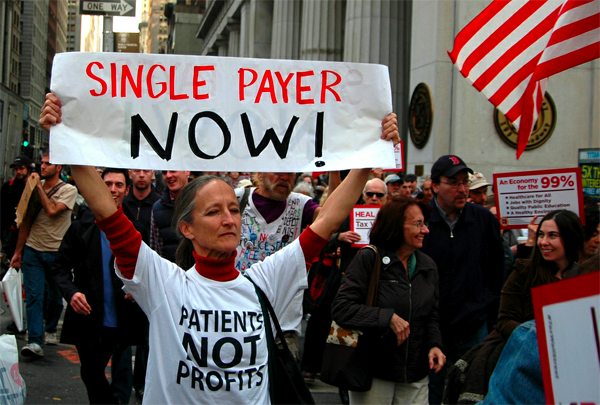Photo: occupywallst.org
The botched Republican attempt at health care reform presents an opportunity to galvanize support for a single-payer system that would bring quality health coverage to all. But healthcare is just one sector that has been ravaged by neoliberal policies. Private companies control more and more aspects of our lives, including our education, our housing, the food we eat, and the water we drink. The fight for a single-payer system should be just one building block in a broader movement against the current political and economic order predicated on the profit of a few through the exploitation of the many.
America’s healthcare problem and the failed attempts to fix it
The two main issues with the American healthcare system are incomplete coverage and increasingly high costs. The US spends the most money in the world on health care, but has lower life expectancy and more prevalent chronic disease than most other high-income countries. Gains in life expectancy over time have been limited largely to affluent white Americans; there are shameful, very much preventable, inequalities in health status across race and class lines.
Obama’s signature piece of domestic legislation, the Affordable Care Act (ACA), was supposed to begin to tackle these issues. The ACA extended the eligible income limit for Medicaid, which is the main reason 26 million Americans gained insurance coverage. It also implemented a number of regulations on the private insurance industry, for example, requiring that all plans cover a set of “essential health services”, including emergency services, mental health services, and pediatric care, thereby addressing to some extent the gaps in coverage across states. The ACA restricted the way private insurers could adjust the cost of their plans based on individual characteristics (for example, insurance companies can no longer charge women or people who have had cancer higher premiums), and it allowed children to stay on their parents’ plans until they are 26 years of age. The ACA also implemented the individual mandate, requiring individuals to purchase health insurance or pay a penalty. The hope was that young uninsured people would buy into insurance plans, to offset the cost of older, sicker people. But this mandate essentially penalizes people for the inability of the American healthcare system to provide coverage for all. None of these regulations addressed the root problem with a market-based healthcare system, which is its necessity to profit from the people it insures. This includes for-profit private hospitals. For example, while some of the increased Medicaid funds were used to increase staffing in both public and private hospitals, a large portion of the funds among for-profit, private hospitals ended up in the pockets of hospital administrators.
Seven years after the ACA was enacted, and three years after most provisions were implemented, there are still 28 million people in the US who lack health insurance. Furthermore, the cost of care has continued to rise, as the power of corporate hospitals, insurance companies and pharmaceutical companies to maximize their profit has gone unchallenged. This has translated into higher co-pays and deductibles, which has prevented people from seeking necessary medical care.
Repeal and Replace
Trump’s first attempted legislative reform, the American Health Care Act (AHCA), sought to repeal the ACA and replace it with a hollow scheme that would have cut funding to the already overburdened public healthcare option and would have strengthened the private insurance industry, all in the name of increased “choice” and reduced “entitlement.” Though the AHCA did not pass, it’s important to understand what it would have entailed because Republicans will likely continue to lobby for some version of it in the future.
The AHCA would have replaced income-based subsidies with age-based tax credits as the funding mechanism for health care. This would have constituted a massive tax cut for the rich. It would have allowed insurance companies to charge older people up to five times more than younger people, rather than three times as it is now. It would have repealed the individual mandate, but replaced it with a requirement that people pay a 30 percent surcharge to their insurance company to sign back up to their plan. It also would have repealed the requirement that all plans cover “essential health services.” All of this would have given private insurance companies even more latitude to cherry-pick healthier and younger individuals, leaving sicker and older people with low-quality and costly plans.
The AHCA also targeted Medicaid. Under the bill, states would have received a capped amount of funding for Medicaid from the federal government, rather than funding based on utilization of services. States with sicker and poorer populations (the two things go hand in hand) would have been disproportionately affected by this. It also would have frozen federal funds for new Medicaid enrollees after 2020. This would have brought more fiscal austerity at the state level, resulting in further cuts to public programs and more pressure on residents. It would have forced the closing of hospitals and clinics that rely more on Medicaid and Medicare, increasing the power of corporate hospitals and large academic centers.
The Congressional Budget Office (CBO) estimated that 24 million people would have lost coverage over the next ten years as a result of Trumpcare, including people who would have been kicked off Medicaid and people who would no longer have been able to afford private insurance premiums because of the subsidy changes. Republicans discredited the CBO report and attempted to push the AHCA through the House, but it was met with major criticism from Democrats as well as Republicans from the very beginning. On March 24th, after only three weeks of negotiation, the vote on the bill was cancelled, despite Republican control of the House, Senate, and presidency. This failure exposed major rifts in the Republican Party, with hardline conservatives arguing that Trumpcare didn’t go far enough to get rid of government-sponsored healthcare, and moderate conservatives concerned about the predicted loss of coverage for 26 million people.
In future iterations of the bill, Republicans may soften the more overtly anti-poor aspects of the bill so as to win support from moderate Republicans; for example, they might keep federal funding for Medicaid, though the hard-right House Freedom Caucus is likely to fight that. What we know for sure is that Republican reform of the healthcare system will continue to focus on strengthening the private insurance market by repealing regulations put in place by the ACA. This will likely include repealing the requirement that plans cover “essential health services,” creating tax incentives to encourage people to purchase private insurance, and facilitating the sale of insurance plans across state lines. This will only worsen the fragmentation of risk pools, making it harder and more costly for older, sicker, and poorer people to obtain health coverage.
Medicare for All
The problem with both the ACA and the failed AHCA is that they keep the market-based system intact. Health care cannot be managed by the “free” market in an ethical and just way. The relationship between a healthcare provider and a patient is not the same as one between a seller and buyer, and treating it that way harms human well-being for the sake of profit. Health care is, after all, a human right.
The inefficiency of the market-based system is the main driver for the rising cost of health care in the US. Insurance companies waste resources on driving sick people away and dissuading them from filing claims in order to maximize their profit. The administrative burden of this complex payment system is estimated to account for $500 billion dollars each year, or a third of total health spending in the US. In addition, the US healthcare system is inefficient and costly because lack of coverage or costly, low-quality coverage prevents people from seeking preventive care. Instead, they wait until they’re forced to seek care in emergency rooms, which are much more costly and do not typically involve much follow up or coordination of care between providers.
Neither Republicans nor Democrats are willing to confront the power of the health insurance lobby, one of the many examples of the ways corporate interests dominate the American two-party system.
An alternative to a market-based healthcare system would be a single-payer, Medicare-for-All system. This would be an expanded and improved version of the existing Medicare system (which has provided health insurance to seniors in the US since 1965) that would ensure access to comprehensive health care among everyone in the US, including undocumented immigrants, regardless of work status or income.
Based on a plan proposed by Physicians for a National Health Program (PNHP), funding for the single-payer system would come from income and payroll taxes, as well as from the immense savings to be gained by getting rid of the administrative overhead of the private insurance industry. There would be no copayments or deductibles. Regional health planning boards – consisting of patients, providers, and researchers – would determine the treatments, medications, and services to include in the benefits package for each region based on community needs and scientific evidence. These boards would also determine provider fees and hospital budgets. Medicare for All would be a form of socialized insurance, in that all healthcare insurance would be paid for using public funds. Providers could continue to work at private, non-profit health facilities, but they would be compensated solely through the public, single-payer system. (This is unlike socialized medicine, where the healthcare delivery system itself is managed by the government and healthcare providers are government employees, as in England’s National Health Service.) However, the PNHP plan calls for for-profit, investor-owned hospitals, which have been associated with higher risk of death for patients, to be converted into non-profit hospitals, ensuring that public funds don’t end up enriching corporate administrators. Socialized insurance would make the healthcare system more accountable to the public, something that is lacking completely with the current market-based system.
Medicare for All would allow people to choose their providers and hospitals without being constrained by narrow insurance networks or worrying about changing jobs. It would facilitate longer-term relationships with providers and coordination of care across facilities and providers, leading to better care for patients. A single-payer system would have much more power to negotiate drug prices with pharmaceutical companies, which would increase access to life-saving medications among low-income people and would help keep health care costs down.
Medicare for All has the support of various advocacy groups including National Nurses United, Labor for Single Payer, and Healthcare NOW. One common problem these groups cite is the complex, suffocating bureaucracy that healthcare workers and patients are forced to navigate because of the multi-payer system. A single-payer system would cut out the bulk of that administrative complexity. There is also much to be gained from the separation of health insurance and employment. Employment-based health insurance worsens health inequities, as people of color and immigrants, who are discriminated against in the labor market, are more likely to be excluded from quality health insurance. Providing health insurance to everyone regardless of employment status would help mitigate social inequities. Detangling health care from employment would also remove health care as a bargaining chip between bosses and workers. Many single-payer advocacy groups note that a transition to Medicare for All should include support for re-training displaced workers affected by the disruption of the private health insurance industry.
No other country in the world manages health insurance through for-profit, investor-owned insurance companies as the US does. Most high-income countries have some form of national health program fund either through a single-payer system, such as in Canada, Denmark, Sweden, and Australia, or through a highly regulated multi-payer system, as in France and Germany. But you don’t have to be a rich country to have a functioning healthcare system – even Argentina and Cuba are able to provide universal access to health care to their citizens.
Trump’s first major legislative failure offers an opportunity to increase support for a public, single-payer system that would provide health insurance to everyone in the US, which, it turns out, is an idea that the majority of Americans support. This is an important cause in and of itself, but the fight for Medicare For All is also a good jumping off point to mobilize around other social issues. The privatization of health care, along with education, housing, and water, are all examples of the same general neoliberal pattern. Companies manage resources in ways that allow company owners and CEOs to profit, while the population becomes increasingly segregated into those who can afford to live dignified lives and those who cannot. Republicans uphold the power of corporations overtly, as is evidenced by the make-up of the current administration. Democrats are against some of this in name but they do not challenge the underlying neoliberal system. The debate around health care highlights this similarity between the two Parties, and should be tackled as part of a broader platform against neoliberalism and the conditions that helped Trump rise to power.










